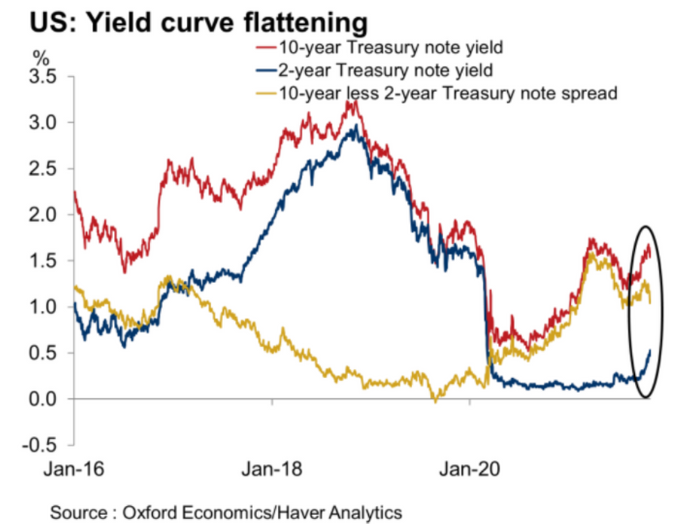Treasury yields rose on Monday ahead of a Federal Reserve meeting this week that’s fully expected to see policy makers announce the tapering of monthly asset purchases. The anticipated move comes amid rising investor expectations the central bank will tighten more aggressively in response to inflation pressures, which have been more persistent than expected.
What are yields doing?
- The yield on the 10-year Treasury note TMUBMUSD10Y, 1.590% rose to 1.591%, compared with 1.555% at 3 p.m. ET on Friday. Yields and debt prices move in opposite directions.
- The 2-year Treasury note yield TMUBMUSD02Y, 0.516% was at 0.521% versus 0.491% on Friday afternoon.
- The yield on the 30-year Treasury bond TMUBMUSD30Y, 1.988% was 1.981%, versus 1.941% on Friday.

The yield curve, a line plotting yields across all maturities, flattened significantly in October (see chart above), a move that accelerated last week. Yields rose sharply at the short end of the curve, with the 2-year rate rising 20.2 basis points in October, the sharpest monthly rise since April 2018, according to Dow Jones Market Data. The 10-year yield fell 9.9 basis points last week, its largest such fall since the week ended July 2.
What’s driving the market?
Many market participants are focused on more persistent-than-expected inflationary pressures, and have significantly moved forward expectations for a rate liftoff by the Fed to as early as June amid an uncertain outlook for global growth. That’s led to the pronounced flattening of the curve, as well as the likelihood of large losses at hedge funds.
Read: Hedge funds seen facing heavy losses amid wrong-way Treasury bets ahead of Fed tapering, traders say
All eyes will be on the Fed’s two-day policy meeting, which concludes on Wednesday. Policy makers are fully expected to announce that the central bank will be scaling back its $120 billion in monthly asset purchases, with Fed watchers looking for the buying program to fully wind down by June. At the same time, Fed Chairman Jerome Powell is expected to emphasize that the conclusion of the asset buying program won’t lead immediately to rate increases.
Investors will also be paying close attention to how the Fed, which has insisted rising price pressures would prove “transitory,” addresses the inflation backdrop, including whether or not it recasts its policy statement.
See: What Federal Reserve tapering means for markets
In data releases on Monday, the final October reading of the Markit manufacturing purchasing managers index came in at 58.4 versus a 59.2 initial estimate. The Institute for Supply Management’s closely watched manufacturing index fell slightly to 60.8% for October from 61.1% in the prior month.
What are analysts saying?
- “Markets are now implying a whopping three hikes in ’22, another 2+ in ’23 and maybe none in ’24,” wrote analysts at Jefferies. “It appears we went from ‘inflation is transitory’ to ‘the Fed could do something panicky’ real quick.”
- “Reflecting more aggressive near-term tightening expectations, the 2-year Treasury yield has jumped 25 basis points since the end of September to 0.53%, the highest level since March 2020,” wrote economists Kathy Bostjancic and Gregory Daco of Oxford Economics, in a note. “The 10-year Treasury yield has held essentially steady, leading to a flattening in the 10 – 2-year Treasury yield spread to 106 basis points. This flattening reflects concern that the Fed will make a policy mistake by raising rates too quickly, slowing economic activity and that inflation will ease significantly in the 5-to-10-year range.”
- “Elevated global rate market volatility has driven a VaR shock,” or the risk of potential losses, “across large levered participants resulting in deteriorating US rates market liquidity as well as worsening liquidity in Europe, Canada and the UK,” according to a BofA Global Research note by Mark Cabana and other strategists. “These moves have exposed still fragile UST market condition.”





